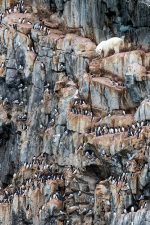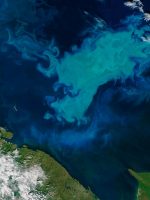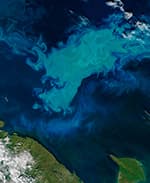
Polar ecosystems in retreat
Altered environmental conditions due to climate change
Climate change is transforming biological communities throughout the world, but most dramatically in the polar regions. In recent decades, the Arctic and regions along the Antarctic Peninsula have warmed so much that the vital physical determinants of life have changed significantly. For the biological communities in the ocean these include:- water temperature,
- ocean currents,
- salt and nutrient content of the water,
- carbon dioxide content of the water (ocean acidification),
- oxygen content of the water,
- volume of sea ice, and
- the frequency of iceberg calving.
- air temperature,
- type and amounts of precipitation,
- duration and extent of snow and ice cover,
- extent of permafrost,
- frequency and intensity of extreme weather events such as heat waves, and
- the amount of coastal erosion.
Two types of adaptation
Organisms react to changes in their environment initially by trying to adapt their behaviour to the new conditions within a short time (acclimatization). Depending on their baseline situation, they may accelerate respiration and metabolism, pump more blood or water and nutrients through the body, perhaps eat more or, if they are mobile, migrate to areas where more familiar environmental conditions prevail. But these attempts at adaptation usually require an output of additional energy that the organisms have to generate. If they can do that, they have a relatively good chance of survival. But if they lack the necessary reserves, individuals may quickly reach their physical limits and be at risk of dying.
However, those individuals who succeed in acclimatizing in the short or medium term usually also reach the age necessary for sexual reproduction and, under optimal conditions, have the chance to adapt genetically over a number of generations. The organisms may produce offspring whose genetic make-up is favourably modified such that the new generation can cope better with the altered living conditions than the parent generation (genetic adaptation).
Both of these options are available to the flora and fauna of the polar regions. For two reasons, however, they represent a major, if not overwhelming challenge. In order to survive in the Arctic and Antarctic regions, most polar animals and plants have already reduced their metabolism and energy consumption so drastically at some time in the past that few of them possess sufficiently large reserves to compensate for the expected temperature increases in the long run. Furthermore, the slow evolutionary processes of many polar marine organisms preclude rapid generational changes. So the possibilities for adapting genetically to the new living conditions in a timely manner are very limited, especially for the more highly developed animals and plants. The outlook is different for organisms with short reproductive cycles. Bacteria, viruses and single-celled algae, for example, reproduce so rapidly that their prospects of genetic adaptation are much better than they are for clams, mussels, fish, birds or mammals. Individual adaptive capacity is therefore not as critical for microorganisms as it is for organisms with longer lifespans.
Ecosystems under pressure
Because the Arctic and some parts of the Antarctic are warming twice as fast as the rest of the world, the highly specialized biological communities in these two regions are under particular pressure. The many species-specific changes that researchers are now observing are represented by the following trends:- In the two polar regions, depletion of sea ice is reducing the size of the habitat for species that use the ice as food source, resting area or nursery ground. Particularly in the Arctic, this means that feeding grounds are shifting poleward with the retreating ice margin. Birds and mammals here that have hunted or fished on the edge of the ice now have to travel greater distances.
- The spectrum of prey for polar predators is changing in the wake of ocean warming.
- The health and fitness of many animals are deteriorating due to food shortages.
- The decline in sea ice and the rising water temperatures are forcing polar sea dwellers to migrate to the few remaining colder regions. Such migrations will be much easier for mobile deep-sea species than for shelf-sea inhabitants that are adapted to life in shallow water.
- The rising air and water temperatures in the Arctic and Antarctic are paving the way to the polar regions for immigrants from the mid-latitudes. These newcomers may then compete with the native species for food. Or they themselves could become a less nutritious prey than the polar species that they replaced in the food web.
- Climate change affects polar biological communities in many ways due to its interactive processes. Various stress factors can either amplify or diminish each other’s effects.
- Exactly how climate-induced changes alter the lives of animals and plants in the polar regions depends to a large extent on regional conditions. The course as well as the degree of change can thus vary greatly from region to region.
Sea-ice retreat – the pantry is shrinking
The retreat of Arctic and Antarctic sea ice is already having a fundamental impact on biological communities, and on the individual species that depend directly or indirectly on the sea ice in any way. The thinner the ice is, the more light is able to reach the ice algae in the spring, and the earlier the important algal blooms begin. Researchers believe that thinner sea ice in the Arctic that also melts earlier will initially boost primary production because the algae in the ice and in the water column will be exposed to more light through the course of the year. But there are two important requirements for increased algal growth. First, the ice and seawater must contain sufficient nutrients. The second requirement is that the amount of snow on the sea ice must not increase. A thick snow cover would prevent sunlight from penetrating through to the ice algae. A more stable stratification of the upper water masses could also inhibit their growth. When sea ice melts, the freshwater content of the upper water layer increases. As a consequence, the low-salinity surface water does not mix as readily with the denser, heavier, more saline and nutrient-rich deep water.
- 4.31 > Body of a dead grey whale north of San Francisco. It is one of more than 200 whale corpses that have been found on the west coast of the USA, Canada and Mexico since the beginning of the year.
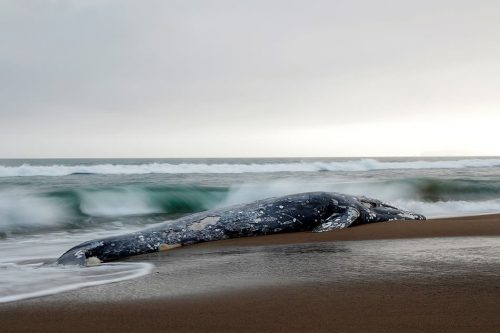
- Computer simulations of sea-ice development in the Arctic region indicate that future ice-algae blooms will begin much earlier in the year. This temporal shift, in turn, threatens the survival of copepods as well as many other species of zooplankton whose life cycles have always been closely synchronized with the reproductive cycle of the ice algae. Scientists have been observing a decline in ice-associated amphipods around Svalbard, for example, since the 1980s. Premature ice-algae blooms, or even their complete absence, could initiate a fatal chain reaction such as the one recently observed in the northern Pacific Ocean.
In the past, ice algae have accounted for 60 per cent of the primary production in this region. But in the winter of 2017/2018, the area of sea ice around Alaska attained a size of just half of what was there in 1978. Accordingly, the subsequent ice-algae bloom in that year was also small. As a result, the zooplankton that feed on the ice algae starved first. The next victims were probably the fish species living under the ice, because the following summer the inhabitants of Alaska observed an abnormal number of seabird deaths. Large numbers of the common murre (Uria aalge), which preferentially preys on iceassociated fish such as polar cod (Boreogadus saida) and capelin (Mallotus villosus), starved to death. Just a few months later, by August 2019, the bodies of more than 200 starved grey whales had washed onto the west coast of North America. The animals presumably died because they could not find enough food during the previous summer in their Arctic feeding grounds in the Bering Sea and in the Chukchi and Beaufort Seas. Grey whales are the only baleen whales that search for food on the sea-bed. They filter amphipods, worms, mussels, fish eggs and other bottom dwellers out of the mud, and accumulate an abundance of fat reserves in the Arctic before migrating to the Gulf of California for the birth of their calves.
- 4.32 > The winter sea ice in the Bering Sea is steadily retreating. At the end of the winter of 2018 it covered the smallest area of sea since the beginning of satellite measurements. Researchers believe that the causes include increasing air temperatures due to the meandering jet stream, combined with warmer water temperatures.

- The ice-related collapse of fish stocks in the Pacific sector of the Arctic Ocean also had an impact on Alaskan fishermen. In the past, they had caught economically important species such as Alaska pollock (Gadus chalcogrammus) and Pacific cod (Gadus macrocephalus) in the Bering Sea. These species both prefer cold water masses, like those that previously formed a kind of cold-water pool in the Bering Sea. But in 2018 this pool was smaller than it had ever been before, presumably due to the absence of winter sea ice. At any rate, the schools of fish followed the cold water northward and out of the reach of the fishermen. If this chain of events is repeated in the coming years, the continued survival of the lucrative fishing industry in the Bering Sea will be seriously threatened. In 2017 the fishermen still caught and processed Alaska Pollock with a value of 1.3 billion US dollars. However, if the stocks permanently migrate to the north, the operation of the large industrial ships will no longer be profitable. With regard to the continuing decline of sea ice in the Bering Sea, researchers are talking about an imminent regime change. By this, they mean the transformation of a polar marine ecosystem once focused on sea ice as the central component of the habitat and food supply, into a more temperate system, in which sea ice and its associated species play virtually no role.
- 4.33 > Because there is no longer sufficient summer sea ice off the Arctic coasts of Alaska and Russia, around 100,000 Pacific walruses have come to a beach on the Chukchi Sea to rest from their hunting excursions and give birth to their young. These mass gatherings have also taken place in the past, but as the sea ice recedes further, they are occurring more frequently.
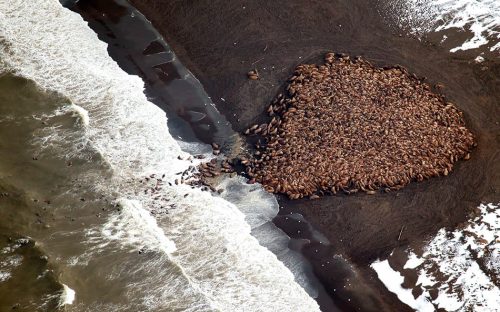
Too little ice for walruses and polar bears
The retreat of sea ice in the Bering Sea is also altering the living conditions for the Pacific walrus (Odobenus rosmarus divergens). Up to 3.6 metres long and weighing as much as 1900 kilograms, the walruses search for food on the sea floor of the Bering and Chukchi Seas, and in the past they would sleep in small groups on ice floes floating near their fishing grounds. The cows also delivered their calves on the ice and raised them there. But since 2007, researchers have been observing that the walruses are now much more rarely finding ice floes to use as resting platforms. Instead, the animals are forced to make their way back to the land. They often come by the thousands to coastal areas sheltered from the wind and waves. Exhausted and densely packed, they lie on the beaches in groups of up to 100,000 individuals. If the walruses are disturbed in this kind of situation, either by polar bears, airplanes or people, a state of mass panic can result. The heavy animals take flight blindly into the sea, ploughing through any individuals that are not able to get out of the way in time. Many of the calves do not survive this kind of mass panic.
Such stampedes, however, are not the only consequence of climate change for these large pinnipeds. With the increasing water temperatures in the Pacific sector of the Arctic Ocean, the food supply for the walruses is also undergoing changes. Subarctic bottom dwellers and po-tential prey animals like the graceful decorator crab (Oregonia gracilis) are migrating from the south into the Chukchi Sea, and are invading new habitats. Furthermore, the distances from the coast to the ice edge are becoming steadily greater for the animals. Native inhabitants of Alaska report that they are increasingly finding deep-sea fish in the stomachs of the walruses they hunt and significantly fewer mussels – an observation that indicates that the spectrum of prey for the large mammals is changing. What impacts these changes will have on the population as a whole remains to be seen. In the case of harp seals and hooded seals on the Atlantic side of the Arctic Ocean, researchers are already recording a decline in the birth rate, diminishing overall health, and dwindling populations. Scientists attribute these developments similarly to the decline of sea ice.
- 4.34 > The Arctic polar bears are divided into 19 geographic groups whose population numbers are insufficiently known to researchers. In 2019, reliable data was available from only eight regions.

- 4.35 > A hungry polar bear preys on a colony of breeding seabirds on Coburg Island in Nunavut, Canada.
- The outlook for polar bears is also discouraging. With the disappearance of sea ice, climate change is destroying the only habitat on which they can find sufficient food. Recent findings indicate that the bears require 60 per cent more energy than was previously thought. Even on days when the animals hardly move, they still burn more than 12,000 calories. This basic requirement can only be met by preying on ringed seals (Pusa hispida) and bearded seals (Erignathus barbatus), which the bears hunt on the sea ice. Any other food source would not be sufficient to ensure the survival of the bears. In recent years, young polar bears in particular have been observed searching for alternative food sources on land. These animals were eating berries and kelp, chasing ducks and small mammals, and raiding the nests of snow geese (Chen caerulescens) and thick-billed murres (Uria lomvia).
Scientists therefore assume that, in the long run, the unchecked decline of Arctic sea ice will lead to extinction for the polar bears. The hunt for seals can only be successful on the ice, where they initially prey on young animals in the late spring. These are still unable to escape into the water at this time, and as prey they have a fat content of 50 per cent. Then, when the new generation of seals are able to take refuge in the sea, the bears wait to ambush them at one of their many breathing holes.
Polar bears that have year-round access to the ice can hunt for seals at any time. Animals that live in regions where the sea ice melts extensively in summer have to spend the ice-free time on land and must fast most of the time. The longer these bears are unable to hunt at sea, the greater the danger of starvation becomes. In computer models, biologists have calculated mortality rates for adult bears in the western Hudson Bay. These indicate that three to six per cent of all adult males will die when the summer fasting period lasts 120 days. If the period is extended by 60 days, to a total of 180, 28 to 48 per cent of the bears will be threatened by starvation. Extended periods of fasting have also been shown to disrupt the reproductive capacity of these carnivores. In years when there is little sea ice, female polar bears give birth to fewer and smaller cubs, and mortality rates for the offspring increase.
- 4.36 > As long as the absence of sea ice deprives the polar bears of access to the seal hunting grounds, they will search for food on land, for example in the garbage dumps of Arctic communities.
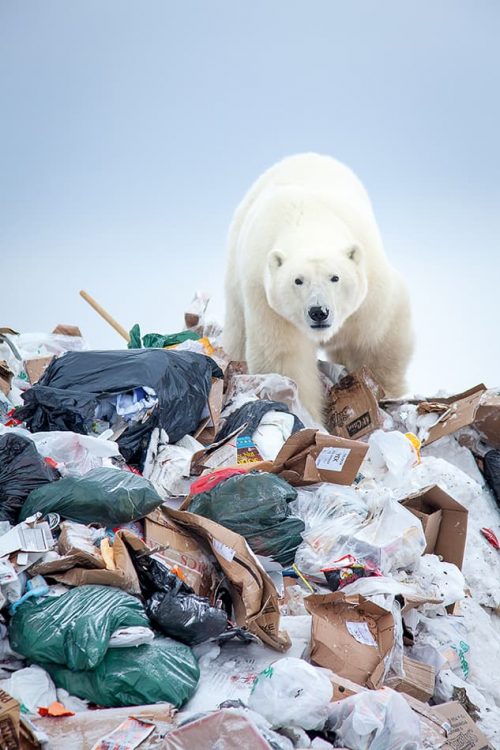
- The decrease in average sea-ice thickness is a further factor causing problems for the polar bears, because thinner ice floes drift faster. The increased drift speed means that they will have to make a greater effort to continue hunting in their traditional territory. The greater effort, in turn, means an increased energy demand that the animals will have to meet. This is a challenge that is driving the bears increasingly closer to human settlements, or into regions where they have rarely been seen before. In June 2018, for example, a polar bear visited Summit Camp, a US research facility on the Greenland ice sheet. The station lies at an elevation of 3200 metres, and is located more than 400 kilometres from the nearest coast.
Estimates say that there are around 25,000 polar bears in the Arctic today, comprising 19 different populations. Information on developmental patterns is available for eight of these populations. Only in the Kane Basin south-eastern of Ellesmere Island is the number of bears known to have increased. Scientists suspect that the case is similar for the population in the Davis Strait. So far, the populations in Baffin Bay, the Foxe Basin (Canadian Arctic Archipelago) and the northern Beaufort Sea appear to have remained stable. Conversely, the researchers are reporting declines in the southern Beaufort Sea as well as in the southern and western regions of Hudson Bay. If the scientific predictions are correct, polar bears will die out in these two regions within the next 30 to 40 years. During the same period, the total number of polar bears in the Arctic is expected to plummet by two thirds.
Not enough ice in the krill nursery
In the Antarctic, shrinking of the sea-ice cover has so far been occurring primarily on the western side of the Antarctic Peninsula, which is the nursery area for the krill population of the southwest Atlantic sector of the Southern Ocean (20° to 80° West). This community accounts for more than half of the total population, and is thus the largest concentration of krill in the Antarctic region. Scientists have analysed catch and size data for the krill over the past 90 years and found evidence of very fundamental change. Not only has the total number of krill decreased by more than 50 per cent, the large swarms today are located much further to the south than they were in the 1920s. At that time, the largest summer occurrences were around South Georgia. Now, however, these crustaceans live mainly along the northern and western coasts of the Antarctic Peninsula. Furthermore, the individual animals today are an average of six milli-metres longer than they were in the 1970s. This observation implies a demographic change within the krill swarms. The populations are now much older than they were earlier, which means that the Antarctic krill are producing fewer offspring, or that fewer of the offspring survive the larval stage.
The primary reason for this is presumed to be the retreat of sea ice on the western side of the Antarctic Peninsula. When ice is scarce the algal blooms are smaller, and the zooplankton species such as krill cannot find enough food in the springtime at the beginning of their reproductive cycle. A deficient food supply in the spring affects egg production and the hatching success of the offspring. In the past, the krill larvae and juvenile animals have been able to hide in the winter from predators, like the Antarctic silverfish, in the cavities, cracks and niches of the sea ice. Without this refuge, however, the crustaceans are at the mercy of their hunters.
- 4.37 > The embryos of the Atlantic cod require water temperatures of three to seven degrees Celsius in order to develop optimally. The eggs, about 1.5 millimetres in diameter, will die if the water is only slightly warmer.

- Furthermore, the krill, also known as “light-shrimp”, encounter altered living conditions in many fjords along the Antarctic Peninsula. Where glaciers have retreated onto the land, meltwater streams wash large quantities of sediment into the fjords and create turbidity in their waters. This pollution impacts krill in two ways. First, turbid water means less light for the various kinds of algae that live in the water column. These are no longer able to carry out a sufficient level of photosynthesis and thus grow much more slowly or die within a short time, and are no longer available as food for the krill. Second, when ingesting food, krill cannot actually distinguish between phytoplankton and sand particles. They consume whatever they filter out of the water. If their food consists mainly of sand grains, the light-shrimp starve. For this reason, the Antarctic krill has already disappeared from Potter Cove, an intensively researched glacial bay on King George Island. Its place in the food web has been taken over by salps, which can cope much better with the murky fjord waters.
The changes in the krill population in the southwest Atlantic sector have clearly left a mark on the species structure of the Southern Ocean. For example, the seals of South Georgia now give birth to calves that are much lighter than they were when the krill swarms were still abundant around the island. The southward migration of krill swarms is also making it difficult for Adélie penguins on the South Shetland Islands and along the west coast of the Antarctic Peninsula to find food. In recent decades their colonies have shrunk by as much as 50 per cent, although the declining krill population is not the only reason for this. Changes in the weather conditions on the Antarctic Peninsula have also played an important role.
Adélie penguins nest on snow-free and ice-free ground. If the breeding birds are caught off guard by rain or heavy melting of snow, their nests may be flooded and eggs or chicks lost. In the past, such losses have contributed to a decrease in the number of Adélie penguins along the Antarctic Peninsula, as have the diminishing krill population and the decline of the ice-associated Antarctic silverfish, another favourite food of the penguins.
- 4.38 > Every organism has a limited temperature range within which it can function and exist. Researchers refer to this range as the thermal window. An organism performs most effectively when the ambient temperature is near the midpoint of its temperature window. If it gets warmer or colder, the functionality of the organism diminishes, even to the point of death. For most organisms, the size of the thermal window changes with increasing age. Fish, for example, can usually tolerate greater temperature fluctuations as young animals than they could in the embryonic stage.

Life at the thermal limit
In recent years, using a wide variety of methods, scientists have been studying how marine organisms respond to rising temperatures. Most of the laboratory studies indicate that cold-loving, ectothermic organisms native to the northern and southern polar seas are much less able to survive a period in warmer water than related species from temperate marine areas. Antarctic invertebrates like the bivalve Limopsis marionensis, the brittle star Ophionotus victoriae, and the brachiopod Liothyrella uva died at water temperatures of only three to four degrees Celsius. This places them among the most heat-sensitive marine organisms in the world.
In order to evaluate the adaptability of an ectothermic marine dweller, scientists determine the size of its thermal window. This refers to the range between the upper and lower temperature limits at which the organism can function smoothly. The width of this window varies depending on the species and the habitat. Animals from more temperate latitudes like the North Sea generally have a wider thermal window. This is necessary because they live in a marine region where the water temperatures vary greatly with the tides and seasons. This means that the animals have to endure the warm temperatures of summer as well as the cold winter conditions. The thermal windows of organisms in the tropics or polar regions, on the other hand, are two to four times smaller than those of the North Sea dwellers.
The temperature limits for a particular species also vary with the age of the individual animal. It has long been assumed that larvae or juvenile animals have the smallest thermal window. It is often stated that a species cannot colonize in places where it gets too warm for them. This statement is true for the Atlantic cod and polar cod, among others. For these two species, a slight increase in water temperature is enough to kill a large proportion of their eggs. Research on a variety of invertebrate animal species from the Southern Ocean, however, indicates that their offspring react very differently to heat. In some studies, the mortality rates of juvenile animals did not increase until the temperature reached a level that was also dangerous for the adult animals. In others, the young animals were even more resistant to heat than the mature generations.
- 4.39 > The embryos of the Atlantic cod require water temperatures of three to seven degrees Celsius in order to develop optimally. The eggs, about 1.5 millimetres in diameter, will die if the water is only slightly warmer.
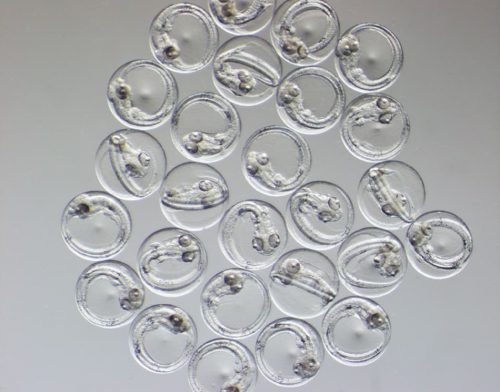
- But it was also revealed that the offspring of polar species develop more rapidly in warmer water. If, for example, the Antarctic sea urchin Sterechinus neumayeri reproduces in water that is 0.5 degrees Celsius warm, the larvae sink to the seabed within 90 days after egg fertilization, where they then metamorphose into young sea urchins. In colder water, at minus two degrees Celsius, the animals require 120 days for this process, whereby the larvae also have more time to drift with the current to more distant regions. If the duration of the larval stage is shortened, there could be ramifications for the lateral distribution of the species.
There is now a basic assumption that most ectothermic animals in the polar regions would be able to survive over the long term in water that is as much as three to four degrees warmer. But if the warming exceeds this upper value, it would cause an increase in mortality and a greater number of deformities in juvenile animals. Another result would be that, for various reasons, the organisms would no longer be able to meet the increasing energy and oxygen demands that accompany rising water temperatures. When the water becomes warmer, all of the natural body processes of ectothermic marine organisms progress faster and therefore require more energy. Among other things, the animals digest the food they consume more rapidly, and a larger proportion of the energy they take in is used for their basal metabolism – the maintenance of basic normal body functions. If the animals ingest the same amount of food under these conditions as they did previously, they end up with less energy reserves for growth and reproduction than they had under colder conditions.
These and similar interactions are particularly threatening during the winter, when there is virtually no primary production in the polar seas due to the paucity of light. In the past, most cold-loving species have simply lowered their metabolism in winter. However, if global warming of the oceans continues, the energy demands will also increase during the polar night when food is scarce. The only individuals that will survive are those who are able to build up sufficient reserves.
- 4.40 > Over generations, ocean dwellers have adapted to the conditions in their native waters, and have developed a corresponding range of temperature tolerance. The range is generally larger for species from the middle latitudes (tuna) than for species in the tropics or polar seas. Tropical and polar organisms commonly live at the upper or lower limits of their comfort zone.

- From long-term studies on fish and other ectothermic organisms in the Antarctic region, it is also known that these species require a relatively long time to adapt to new environmental conditions. In laboratory experiments, up to nine months passed before the animals were able to restructure the fatty acids in their cell membranes to match the adjusted temperatures. This delayed acclimatization weakens the animals over the long term, because it means that many of the processes in their bodies do not function optimally for several months if the external conditions change quickly, as with a change of season, for example. Researchers are assuming that the water temperatures in the Antarctic will continue to fall to near the freezing point for the next one hundred winters. But they also believe that the winters will become shorter and the summers warmer. The cold-loving ocean dwellers will therefore be in a constant state of adaptation and will only rarely experience optimal conditions in the future.
- 4.41 > Calcareous algae and other phytoplankton bloom in the spring and summer in the nutrient-rich waters of the Barents Sea, colouring this Arctic marginal sea bright green to milky blue. Researchers are noting that the magnitude of this algal bloom is increasing in the wake of climate change. At the same time, the blooms are occurring further to the north than they did at the beginning of the 21st century. This is due to the retreat of the Arctic sea ice.
Migration towards the pole
The easiest way for organisms to adapt to global warming is presumably to migrate to areas where familiar temperatures still prevail. For organisms living on land, this would be either the high mountain areas or regions further to the north or south. Sea dwellers, on the other hand, can migrate to greater depths or toward the poles. Researchers have been observing these temperature-induced migrations in plankton, invertebrates, fish and seabirds for decades, including in the peripheral areas of the polar oceans. Phytoplankton in the North Atlantic, for example, have been shifting poleward since the 1950s by a few hundred kilometres per decade. In the Southern Ocean, calcareous algae are found much further south today than they were 20 years ago.
Since the beginning of industrialization, the zooplankton populations of the world’s oceans have migrated an average of 600 kilometres towards the poles to evade rising water temperatures. In regions that have become particularly warm, the ranges of microorganisms have shifted by as much as 2550 kilometres.
The Atlantic cod (Gadus morhua) has already advanced so far to the north in its flight from the heat that it can now be found in large numbers in the waters around Svalbard in the summer. The warm Atlantic water masses overlie cold Arctic waters from the Barents Sea at this time of year, so the cod finds optimal conditions with water temperatures of around four degrees Celsius. Its Arctic relative, the polar cod (Boreogadus saida), on the other hand, has to flee this temperature. As a cold-loving species it prefers water temperatures around zero degrees Celsius. The Intergovernmental Panel on Climate Change predicts that these and other cold-adapted inhabitants of the northern and southern polar seas will see their habitats continue to shrink because there are no other areas of refuge for them in the long run.
- When immigrants from the middle latitudes advance into the polar regions, they may have to compete with established species for food resources. For example, Atlantic and Pacific killer whale populations are now also hunting seals in Arctic waters, and are thus competing with polar bears. Because of the northward migration of the Atlantic cod, the polar cod is confronted with a further competitor for food. Where these two fish species share the sea, they may hunt the same prey.
Immigrating species also change the food structure of the polar regions by becoming prey themselves while being significantly smaller and less nutritious than the native species they have displaced. One example of this is the Atlantic copepod Calanus finmarchicus. It is advancing into the Arctic Ocean via the North Atlantic Current, and in its northern range is now replacing more fat-rich Arctic species such as Calanus glacialis and Calanus hyperboreus. For the predators of copepods, this species substitution means that they have to consume larger volumes of the newcomers in order to obtain the usual amount of energy. Scientists are observing very similar patterns in amphipods.
The polar seas are acidifying
By acting as a gigantic carbon sink, the oceans have absorbed around a third of the carbon dioxide that human activities have released into the atmosphere since the beginning of industrialization. Thus the world’s seas have slowed global warming. However, this absorption also leaves traces, because when carbon dioxide from the atmosphere dissolves in seawater, a profound chemical change occurs in the surface water. Seawater normally has an average pH value of 8.2 and is therefore slightly alkaline. This is because of the mineral components in the water, calcium carbonates such as calcite and aragonite, which were at one time dissolved from weathered stone on land and then washed into the sea.
If the oceans absorb carbon dioxide, however, this gas, unlike oxygen, does not simply dissolve in water. On the contrary – a proportion of the carbon dioxide binds with the water, so that carbonic acid is produced. Anyone who makes their own sparkling water at home in a Sodastream understands this principle. When the button is pressed, carbon dioxide is injected into a bottle of tap water and immediately produces in it the bubbles typical of carbonic acid. To a certain extent, the same thing happens in the sea, but the carbonic acid in the sea is not stable: it breaks down into bicarbonates, the carbonic acid salts, and protons (hydrogen ions). The latter increase the acidity of the water and the ocean becomes more acidic.
- 4.42 > Researchers set up a laboratory experiment in which they kept the Antarctic pteropod Limacina helicina antarctica under the acidified conditions predicted for the year 2100 – assuming that humans do not cut their carbon emissions. The finding: the sea snail’s calcareous shell dissolved within 45 days.
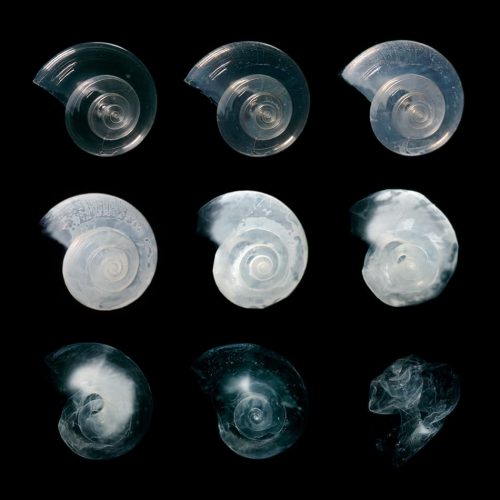
- The measure for the concentration of hydrogen ions in a solution is known as the pH value. However, this numerical value shows the concentration as a negative common logarithm. That means that the more hydrogen ions there are in a solution, the lower the pH value is. Since 1860 the mean pH value of the ocean surface has fallen from 8.2 to 8.1. This apparently small gradation on the logarithmic pH scale corresponds to an actual rise in acidity of 26 per cent – a change that the world’s seas and their inhabitants have not experienced in millions of years. By the year 2100 the pH value of the oceans is predicted to fall by a further 0.3 to 0.4 units, and seawater thus to become one hundred to 150 per cent more acidic. That does not mean that the oceans are actually acidic, as even with values around 7.7 they are still alkaline from a chemical point of view, but they are – in relative terms – more acidic than before.
All marine creatures that breathe in water, such as fish, bivalve molluscs and starfish, have five to 20 times less carbon dioxide in their blood than land-dwellers. That is why scientists assume that water containing more carbon dioxide will affect sea creatures in a different, probably more dramatic way than species that breathe air. If the carbon-dioxide concentration in the bodily fluids of an animal rises, this leads to acidification there too and among other things impairs the transport of substances through cell membranes.
Especially at risk are calcifying organisms such as bivalve molluscs, corals, echinoderms and certain species of plankton, since they need calcium carbonates to form their shells and skeletons. The concentration of these minerals in seawater is falling as acidification increases, however. For the organisms, this means that the more acidic the water becomes, the more effort they have to expend to construct their shells and skeletons. However, the more energy the creatures invest in calcification, the less they have left for other processes essential for survival, such as growth and reproduction. Therefore, in the long term, the size, weight and overall fitness of the organisms decline. Moreover, as acidity levels rise, so too does the danger that the more acidic water will attack existing mollusc and snail shells, and coral reefs, and will damage or even totally destroy them.
Ocean acidification thus affects organisms quite directly – especially in the polar regions, where most organisms already only survive because they have reduced their energy consumption to the absolute minimum. This means that many marine dwellers have almost no energy reserves to cope with the extra pressure of acidification. What makes matters worse is that acidification and warming of the seas go hand in hand. The interaction of the two processes can either increase or decrease the impact of acidification in the ocean, depending on the species. Be that as it may, the effects on individual members of the food web indirectly influence the entire marine community.
Ocean acidification hotspots
The ice-free areas of the Arctic and Antarctic Oceans absorb more carbon dioxide from the atmosphere than the global ocean overall and acidify more quickly than warmer ocean regions. This is primarily due to the still comparatively low water temperatures of the polar seas. Gases such as oxygen and carbon dioxide dissolve more readily in cold water. In addition, the major rivers of the Arctic carry large quantities of organic material into the marg-inal seas. If this is broken down by microorganisms, more carbon dioxide is produced, which accelerates the acidification of the Arctic Ocean. This is particularly true for the Laptev, East Siberian and Chukchi Seas. The melting of the great ice sheets also exacerbates the trend, since if meltwater flows into the sea, it dilutes the water masses. That means that the concentration of calcium carbonate ions falls as well. However, when algae blooms occur, carbon dioxide is removed from the sea and the pH value of the water rises again. Because of this, the pH of seawater is subject to natural fluctuations, especially in the polar seas.
Scientists can already see clear indications that the polar seas are becoming more acidic, but the response of the marine creatures there to the falling pH of the water varies considerably. For example, researchers conducting laboratory and field trials were surprised by the remarkable level of resistance shown by viral and bacterial communities. Some of the bacteria species even grew better in more acidic water than in water with a normal pH value. The phytoplankton proved similarly robust. However, the scientists do not see this as a reason for optimism because once the algae in the experiment reacted to the rising acidity levels, shifts in species assemblages fundamental to the entire food web generally followed.
- 4.43 > Because gases such as oxygen and carbon dioxide dissolve more readily in cold water, the polar seas are acidifying significantly more rapidly than water bodies in the mid- and tropical latitudes. As acidity levels in the polar seas rise, the concentration of vital calcium carbonates in the water falls.

- Organisms benefiting from acidification include large algae such as the Arctic kelp Saccharina latissima, also known as sugar kelp. The increasing carbon-dioxide content of the water facilitates photosynthesis to a certain degree, so that the algae grow better. Moreover, experiments show that Arctic cold-water corals can also construct their calcareous skeleton in a more acidic environment – provided that they find enough food to meet the greater energy demand. However, scientists fear that in the long term the acidification of the water could lead to signs of decay at the base of the reefs. These are composed of limestone formed from dead corals, which could dissolve if acidity levels rise in the Arctic Ocean.
The losers from acidification, on the other hand, include the Arctic and Antarctic sea butterflies (Pteropoda). These animals secrete a calcium carbonate shell. In experiments, researchers observed that the shells were generally smaller and less stable in more acidic conditions, and exhibited greater damage than in water with a normal pH value. The green sea urchin Strongylocentrotus droebachiensis produces fewer young in more acidic water, because the eggs are less well fertilized. Furthermore, the number of deformities among the embryos increases. There is also a gloomy outlook for the echinoderms of the Antarctic shelf seas. These regions of the ocean are predicted to acidify so rapidly that echinoderms such as sea urchins and starfish will have to migrate into deeper waters to avoid being harmed by the higher acidity.
Second to marine mammals, fish are among the most highly developed creatures in the oceans. They have complex regulation mechanisms that enable them to adapt to changing temperatures and carbon-dioxide concentrations in the water. Fish neutralize the surplus carbon dioxide in their bodies using acidity-regulating processes in their gills, intestinal tract and liver. Biologists have studied this effect extensively and established that fish can compensate for a lower pH value within a few hours.
- However, the scientists also discovered that these mechanisms only function fully in adult fish. Juvenile fish, on the other hand, are not yet able to protect themselves adequately, and react significantly to acidification of the sea; this is the case with juvenile cod, for example. In acidification experiments, smaller numbers of fish larvae were released from the egg; they were noticeably smaller at this stage than in normal environmental conditions and needed more oxygen. At the same time, twice as many juvenile fish died in the first 25 days of life at the pH values forecast for the end of the 21st century than under today’s conditions. Studies using young Atlantic herring (Clupea harengus) showed that the juvenile fish exhibited organ damage and deformities more often in acidified water. These became more severe as the acidity of the water in the test basins increased.
Such species-specific consequences of ocean acidification indirectly alter the entire species structure of the polar seas, for example, when one species experiences a clear competitive disadvantage as a result of acidification, while its rivals remain unaffected. Biologists believe, for instance, that in the future non-calcifying algae will have considerably better conditions for growth than calcifying algae. In the long term, a development of this kind could mean that in places where large kelp forests exist today, dense carpets of a more mat-like algae will flourish in the future. Another consequence of acidification could be, however, that important limestone structures in the sea disappear – and with them the species that live on or in these structures. Especially at risk are cold-water coral reefs and mussel and maerl beds. The latter are coastal sand or shingle banks made up of more than 50 per cent ramified living and dead red algae. Mussel beds provide a source of food for many seabirds, and for marine mammals such as the walrus. Should they die as a result of acidification, a vital livelihood base will be lost, not only for the more highly evolved animals, but for humans as well.
The situation is exacerbated by the interaction of ocean acidification and rising sea temperatures. A major meta-analysis has shown that Arctic marine dwellers react more sensitively to more acidic water if their environment becomes warmer at the same time. This is the case with sea butterflies and fish. For example, if the acidification and warming of the Barents Sea continues as it has to date, the cod population there, which is of enormous importance for the fishing industry, will probably collapse by the end of this century. On the other hand, studies on Antarctic fish and sea urchins showed clearly that temperature changes put the animals under considerably more stress than the increasing acidity of the water, to which many creatures in the trials were able to adapt. Nevertheless, to do this they required a great deal of time, which they are unlikely to have in their natural environment.
The wide variations in the responses of individual species to the ongoing acidification and warming of the polar seas make it difficult for scientists to draw general conclusions. Moreover, there are no conclusive long-term studies, especially for the Antarctic, that consider multiple environmental factors. However, all findings and prognoses so far indicate that the falling pH of the water will be accompanied by fundamental changes to the biotic community, which, in the Arctic at least, will also have a direct effect on human societies.
- 4.44 > Reindeer in the Svalbard Archipelago have developed the habit of eating seaweed washed up by the sea in winters with frequent rain and frozen snow or ice covers.
Changes for animals on the land
Climate change is also altering the land areas in the polar regions, and therefore the habitats of their occupants, especially in the Arctic. In many regions today, the snow cover is melting much earlier in the year, the sea ice is retreating earlier and for longer durations, and the vegetation is beginning to sprout earlier in the year because of the warmer temperatures. These changes have consequences. Researchers note that the distributional ranges of polar species are shifting northward as subarctic species advance into the southern reaches. The entire tundra is in motion; even the elk are on the move, as a Siberian reindeer herder observed more than five years ago.
In the future, the changes will probably be even more dramatic because, even if humankind is able to limit average global warming to two degrees Celsius, the air temperatures in the Arctic region will rise by 2.8 to 7.8 degrees Celsius and pave the way for species from more southern realms. The unique biological communities of the high Arctic lands are threatened with extinction in the long run because their northward retreat is limited by the Arctic Ocean. Only those polar species that are able to migrate to higher elevations or to remote islands will have a prospect of survival.
Which species survive in the Arctic in the future will primarily be determined by the winter conditions. Temperature stress and flooding due to strong rains or sudden snow melt, for example, threaten small rodents like lemmings, which in the past have been able to find protection from cold and predators beneath the snow. Ice-rain or freezing of the snow cover also hinders caribou, reindeer and musk oxen in their search for food. In this situation, the lichens, which are essential for their subsistence, are so firmly embedded in the ice that the animals cannot scratch them free with their hooves. The animals are threatened with starvation, especially the herds living on Arctic islands or in very isolated areas where there is little chance of migrating to other regions. The reindeer in western Svalbard have begun to look for food on the beaches in winters when the ground is heavily iced over. The animals wander along the coast and eat washed up kelp and other seaweed. The salty algae, however, appear to be just a stopgap solution, because in winters with normal polar weather conditions the animals again take up the search for lichens.
Increased warming in the Arctic is also disrupting nature’s basic calendar. The sequence of important biological processes is undergoing a shift in time. The vegetation in some regions of Greenland is now beginning to grow 30 days earlier in the year. But the reindeer calves are still being born at the usual time because the reproductive cycle of the animals is determined by the length of the days and not by temperature. So, while the reindeer cows and their offspring were previously finding the qualitatively best food at exactly the right time, they are now showing up too late, and this has resulted in higher mortality rates for the calves.
Changes in polar vegetation
With regard to vegetation, researchers have been considering for several decades the question of whether the combination of warming and higher atmospheric carbon dioxide levels will boost plant growth in the northern polar region, or whether the increasing heat will be harmful to cold-adapted plants and rather lead to a long-term decrease in species diversity.
The answer so far has been: both, because developments are not homogeneous. In some regions of the Arctic tundra researchers have observed an increase in plant biomass (Arctic greening). This means that the plants are experiencing a boost in their metabolism, especially in response to the higher summer temperatures. They are emerging earlier and growing stronger, and they are expanding northward. This pattern is especially prevalent on the North Slope of Alaska and in the southern tundra regions of Canada and East Siberia. In these areas, bushy willows and alders grow much higher today than they did in the past. The shoots of the shrubs are thicker and the plants develop more branches and twigs. Plants like the mountain sorrel (Oxyria digyna) appear earlier in the year and bear larger and greener leaves, and grasses are now sprouting in many exposed sites where previously only gravel was found.
- 4.45 > Researchers have been using satellite data since the 1970s to observe the development of vegetation patterns in the Arctic region. With the help of this data from space they have created the Normalized Difference Vegetation Index (NDVI). The more vascular plants grow in a region, the higher this value is (Arctic greening). But when the vegetation dies, the index falls (Arctic browning).

- However, there are also areas where the opposite trend is prevalent, where vegetation density and biomass are declining despite the rising summer temperatures (Arctic browning). These regions include, for example, the Yukon-Kuskokwim Delta in western Alaska, the High Arctic in the Canadian Arctic Archipelago, and the north-western Siberian tundra. Various extreme events here, such as episodes of winter heat with sudden snow melt, icing over due to unusual winter rains, tundra fires, persistent drought or plagues by various pests in the neighbouring forests have created adverse conditions for the plants. Furthermore, with the thawing of permafrost the dangers of flooding, standing water in depressions, and erosion have increased.
Because of these varied developments, scientists are certain that climate change will generate complex interplay among the vegetation, the atmosphere, the permafrost soils, and plant-eating animals. The amount of warming alone does not determine whether the vegetation cover becomes denser and greener in a certain region. What increased plant growth does indicate is that an area is responding in its entirety to warming.
Looking to the future, it is still uncertain whether plant growth in the Arctic region will generally increase if climate change progresses to a degree such that the temperature is no longer a limiting factor for the vegetation. Computer simulations predict that the vegetation will continue to advance northward. If humankind does not drastically reduce its carbon dioxide emissions, there will only be a few areas in the Arctic by the end of the 21st century where it will still be cold enough to prevent the growth of plants. But even then, the Arctic region will probably not be a favourable environment for an abundance of plants. As long as the Earth’s axis maintains its tilt, the winters in the polar regions will continue to be long and dark, and the summer growing season will be so short that it will present a huge challenge to plant growth.
- 4.46 > On Herschel Island in far northern Canada, plant growth has increased in the wake of climate change, as these two photographs illustrate. The image on the left was taken in 1987 and the one on the right two decades later.
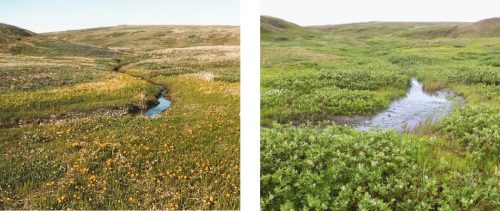
Risk escalates with rapid change
It has taken millions of years for the Arctic and Antarctic animal and plant worlds to adapt to the extreme living conditions in the polar regions. By comparison, the present climatic changes driven by global warming are happening so fast that the polar ecosystems and their highly specialized organisms are in danger of not being able to adapt quickly enough. Human-induced climate change therefore poses a massive threat to the diversity of polar biological communities and to their functionality.
Today, we know that the feeding interrelationships in the polar ecosystems are much more complex and diverse than was previously understood. Similarly, we still know relatively little about the biodiversity of many groups of polar organisms. In 2014, for example, scientists had sufficient information on less than two per cent of the Arctic organisms to be able to recognize climate-induced changes in their behaviours. The researchers are therefore still unable to say much about the possible reactions of the affected biological communities. In the areas that have been well researched, however, one thing is very clear: Where climate change is already having an impact, the natural polar biological communities look different today than they did prior to industrialization.
